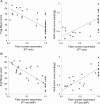Structural integrity of corticospinal motor fibers predicts motor impairment in chronic stroke
- PMID: 20101033
- PMCID: PMC3122304
- DOI: 10.1212/WNL.0b013e3181ccc6d9
Structural integrity of corticospinal motor fibers predicts motor impairment in chronic stroke
Abstract
Objective: Motor impairment after stroke has been related to infarct size, infarct location, and integrity of motor tracts. To determine the value of diffusion tensor imaging (DTI) as a predictor of motor outcome and its role as a structural surrogate marker of impairment in chronic stroke, we tested correlations between motor impairment and DTI-derived measures of motor tract integrity.
Methods: Thirty-five chronic stroke patients with varying degrees of recovery underwent DTI and motor impairment assessments. Fibers originating from the precentral gyrus were traced and separated into pyramidal tract (PT) and alternate motor fibers (aMF). Asymmetry indices of fiber number and regional fractional anisotropy (FA) values comparing lesional with nonlesional hemispheres were correlated with motor impairment scores and compared to an age-matched control group.
Results: Fiber number and regional FA value asymmetry significantly differed between the groups with lower values in the patients' lesional hemispheres. Both measures significantly predicted motor impairment with stronger predictions when all motor tracts were combined as compared to predictions using only the PT. The pattern of motor tract damage (PT only vs PT and aMF) led to a classification of mild, moderate, or severe impairment with significant between-group differences in motor impairment scores.
Conclusions: Diffusion tensor imaging-derived measures are valid structural markers of motor impairment. The integrity of all descending motor tracts, not merely the pyramidal tract, appears to account for stroke recovery. A 3-tier, hierarchical classification of impairment categories based on the pattern of motor tract damage is proposed that might be helpful in predicting recovery potential.
Figures




Comment in
-
Stroke recovery: the pyramid in focus.Neurology. 2010 Jan 26;74(4):276-7. doi: 10.1212/WNL.0b013e3181ccc758. Neurology. 2010. PMID: 20101032 No abstract available.
Similar articles
-
Predicting functional motor potential in chronic stroke patients using diffusion tensor imaging.Hum Brain Mapp. 2012 May;33(5):1040-51. doi: 10.1002/hbm.21266. Epub 2011 Apr 29. Hum Brain Mapp. 2012. PMID: 21538700 Free PMC article. Clinical Trial.
-
Motor recovery and microstructural change in rubro-spinal tract in subcortical stroke.Neuroimage Clin. 2013 Dec 13;4:201-8. doi: 10.1016/j.nicl.2013.12.003. eCollection 2014. Neuroimage Clin. 2013. PMID: 24432247 Free PMC article.
-
Diffusion tensor imaging, permanent pyramidal tract damage, and outcome in subcortical stroke.Neurology. 2010 Sep 21;75(12):1048-54. doi: 10.1212/WNL.0b013e3181f39aa0. Neurology. 2010. PMID: 20855848 Free PMC article.
-
Prediction of motor outcome for hemiparetic stroke patients using diffusion tensor imaging: A review.NeuroRehabilitation. 2010;27(4):367-72. doi: 10.3233/NRE-2010-0621. NeuroRehabilitation. 2010. PMID: 21160127 Review.
-
Diffusion tensor imaging as a prognostic biomarker for motor recovery and rehabilitation after stroke.Neuroradiology. 2017 Apr;59(4):343-351. doi: 10.1007/s00234-017-1816-0. Epub 2017 Mar 14. Neuroradiology. 2017. PMID: 28293701 Review.
Cited by
-
Structural connectivity analyses in motor recovery research after stroke.Ann Clin Transl Neurol. 2016 Jan 19;3(3):233-44. doi: 10.1002/acn3.278. eCollection 2016 Mar. Ann Clin Transl Neurol. 2016. PMID: 27042683 Free PMC article. Review.
-
Transcranial direct current stimulation for gait recovery following stroke: A systematic review of current literature and beyond.Front Neurol. 2022 Sep 7;13:953939. doi: 10.3389/fneur.2022.953939. eCollection 2022. Front Neurol. 2022. PMID: 36158971 Free PMC article.
-
Combined Diffusion Tensor Imaging and Arterial Spin Labeling as Markers of Early Parkinson's disease.Sci Rep. 2016 Sep 20;6:33762. doi: 10.1038/srep33762. Sci Rep. 2016. PMID: 27646647 Free PMC article. Clinical Trial.
-
Repetitive Transcranial Magnetic Stimulation Induces Quantified Functional and Structural Changes in Subcortical Stroke: A Combined Arterial Spin Labeling Perfusion and Diffusion Tensor Imaging Study.Front Hum Neurosci. 2022 Apr 6;16:829688. doi: 10.3389/fnhum.2022.829688. eCollection 2022. Front Hum Neurosci. 2022. PMID: 35463928 Free PMC article.
-
Neural bases characterizing chronic and severe upper-limb motor deficits after brain lesion.J Neural Transm (Vienna). 2023 May;130(5):663-677. doi: 10.1007/s00702-023-02622-9. Epub 2023 Mar 21. J Neural Transm (Vienna). 2023. PMID: 36943506
References
-
- Pineiro R, Pendlebury ST, Smith S, et al. Relating MRI changes to motor deficit after ischemic stroke by segmentation of functional motor pathways. Stroke 2000;31:672–679. - PubMed
-
- Schiemanck SK, Kwakkel G, Post MW, Kappelle LJ, Prevo AJ. Impact of internal capsule lesions on outcome of motor hand function at one year post-stroke. J Rehabil Med 2008;40:96–101. - PubMed
-
- Duncan PW. Stroke disability. Phys Ther 1994;74:399–407. - PubMed
-
- Cramer SC, Seitz RJ. Imaging functional recovery from stroke. In: Handbook of Clinical Neurology 2008;94:1097–1117. - PubMed
-
- Lang CE, Schieber MH. Human finger independence: limitations due to passive mechanical coupling versus active neuromuscular control. J Neurophysiol 2004;92:2802–2810. - PubMed
Publication types
MeSH terms
Grants and funding
- R01 NS047029-04A2/NS/NINDS NIH HHS/United States
- 1P50 CA101942-01/CA/NCI NIH HHS/United States
- 1R01NS045049/NS/NINDS NIH HHS/United States
- 1R01 DC008796/DC/NIDCD NIH HHS/United States
- 1R21 CA121570A1/CA/NCI NIH HHS/United States
- R01 DC009823-01/DC/NIDCD NIH HHS/United States
- R01-EB004582/EB/NIBIB NIH HHS/United States
- R01 NS045049/NS/NINDS NIH HHS/United States
- R01 MH80729-01A2/MH/NIMH NIH HHS/United States
- 1 R01 AG027435-01/AG/NIA NIH HHS/United States
- R01 DC008796/DC/NIDCD NIH HHS/United States
- 1 R01 CA115745-01A1/CA/NCI NIH HHS/United States
- R01DC008796-01A1/DC/NIDCD NIH HHS/United States
- R01 DC009823/DC/NIDCD NIH HHS/United States
- R01 MH077073-01A2/MH/NIMH NIH HHS/United States
LinkOut - more resources
Full Text Sources
Other Literature Sources
Medical
